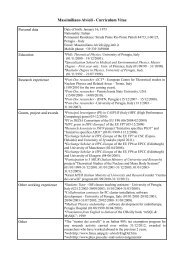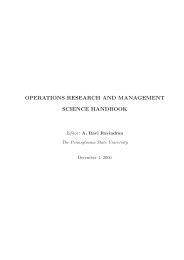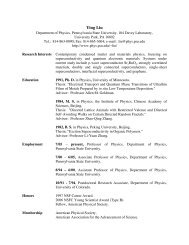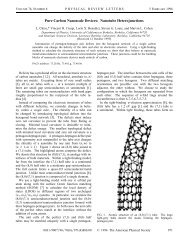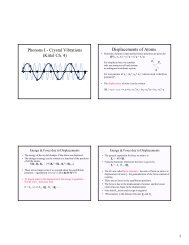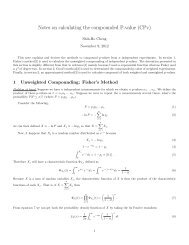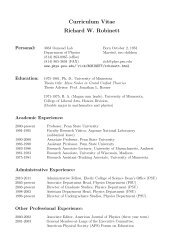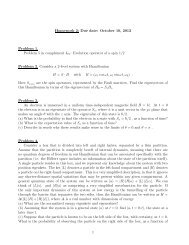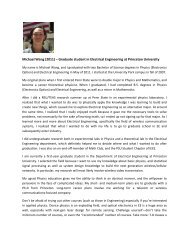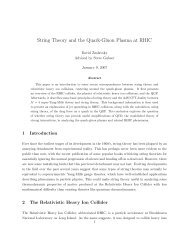Network models â random graphs Random networks Random graph
Network models â random graphs Random networks Random graph
Network models â random graphs Random networks Random graph
You also want an ePaper? Increase the reach of your titles
YUMPU automatically turns print PDFs into web optimized ePapers that Google loves.
The properties of <strong>random</strong> <strong><strong>graph</strong>s</strong> depend<br />
on p<br />
Properties studied:<br />
is the <strong>graph</strong> connected?<br />
does the <strong>graph</strong> contain a giant connected component?<br />
what is the diameter of the <strong>graph</strong>?<br />
does the <strong>graph</strong> contain cliques (complete sub<strong><strong>graph</strong>s</strong>)?<br />
Probabilistic formulation: what is the probability that a <strong>graph</strong> with<br />
N nodes and connection probability p is connected?<br />
Increase p from 0 to 1. Some of these properties appear suddenly,<br />
at a threshold p c (N)<br />
lim P<br />
N<br />
→∞<br />
N ,<br />
( Q ) =<br />
p<br />
0 if<br />
1 if<br />
p(N )<br />
→ 0<br />
p ( N )<br />
c<br />
p(N )<br />
→ ∞<br />
p ( N )<br />
c<br />
Ways of selecting<br />
n nodes from N<br />
Sub<strong><strong>graph</strong>s</strong> of a <strong>random</strong> <strong>graph</strong><br />
Consider a sub<strong>graph</strong> with n nodes and e edges.<br />
Expected number of of these sub<strong><strong>graph</strong>s</strong> in a <strong>graph</strong> with N nodes<br />
and connection prob. p<br />
We can permute<br />
n e n!<br />
the n nodes in any<br />
E( X ) = C<br />
N<br />
p<br />
a<br />
way we want...<br />
Probability of<br />
having e edges<br />
Isomorphic <strong><strong>graph</strong>s</strong>: there exists a<br />
one-to-one mapping of the nodes<br />
in such a way that if (and only if)<br />
node i and j are connected in one<br />
then their images i’ and j’ are also<br />
Connected.<br />
but identical<br />
(isomorphic) <strong><strong>graph</strong>s</strong><br />
do not count<br />
Special sub<strong><strong>graph</strong>s</strong><br />
Consider a sub<strong>graph</strong> with n nodes and e edges.<br />
Expected number of sub<strong><strong>graph</strong>s</strong> with n nodes and e edges in a<br />
<strong>graph</strong> with N nodes and connection prob. p<br />
n e<br />
n e n! N p<br />
E( X ) = C<br />
N<br />
p ≅<br />
a a<br />
If the connection probability is a function of the number of the<br />
nodes, we can find the condition of having a non-vanishing<br />
number of sub<strong><strong>graph</strong>s</strong>.<br />
lim<br />
N→∞<br />
n / e<br />
p( N )N<br />
≠ 0<br />
Ex. Find the condition of having a non-vanishing number of<br />
trees, cycles and completely connected sub<strong><strong>graph</strong>s</strong>.<br />
Evolution of a <strong>random</strong> <strong>graph</strong><br />
Assume that the connection probability is a power-law of N,<br />
Assume that z increases from − ∞ to 0<br />
Look for trees, cycles (circuits) and cliques in the <strong>graph</strong>.<br />
Appearance thresholds:<br />
The <strong>graph</strong> contains cycles of any length if z ≥ −1<br />
z<br />
p = cN<br />
2



